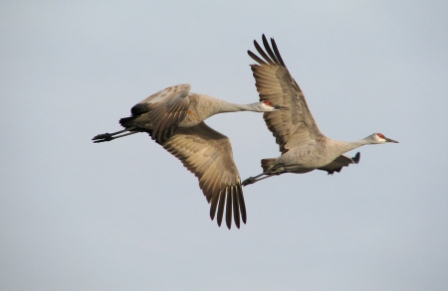The annual mystery

It is the time of year when we can count among our blessings living beneath a Sandhill Crane flyway. The sound of the cranes’ trumpets is one of the autumn rites of passage that makes up for the absence of hummingbirds and the coming of winter. Cranes congregate in huge numbers during migration periods, and many groups winter in open fields here, while many more head to the Bosque del Apache Wildlife Refuge.
So what is bird migration all about? What are the triggers that cause birds to undertake strenuous journeys involving hundreds and often thousands of miles? The primary reason birds migrate is to find food and nesting locations. If birds stayed in the same area all the time, food resources would become scarce in breeding areas, and many birds (especially chicks) would not survive. There would be greater competition for nesting sites, and larger numbers of predators would be attracted. In general, birds that nest in the northern hemisphere travel south for the winter as insects and other food resources grow scarce.
Escaping cold may be another factor in migration, although some birds can survive harsh temperatures with sufficient food. Occasionally even hummingbirds have been known to stay in the Albuquerque area for the winter, and they can survive by going into a state of torpor (similar to hibernation, where body temperature and metabolism drop).

How birds navigate during migration remains one of the unsolved mysteries. How is it that some birds are able to follow the exact same route from year to year? Even first-year migrants follow routes they’ve never seen before, and return the next season to their original breeding ground. Birds appear to navigate using a variety of techniques, including possibly guidance by the stars and sun, sensing changes in the Earth’s magnetic field, and even by sense of smell. In the case of our beloved sandhill cranes, juveniles learn routes from their parents and other adults in the flock. Once learned, they can repeat the journey themselves.
New techniques of studying migration, including radar records, satellite monitoring, and attaching birds with miniature transmitters, may eventually solve the mysteries of migration and the annual journeys of these remarkable creatures.
Roberta Beyer Winchester is a bird-lover and owner of The Fat Finch, an online boutique for bird-lovers.
